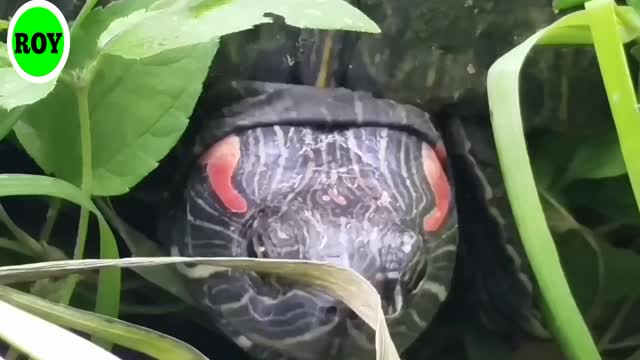Premium Only Content

Watch his video on different species of tortoises
Habitat and habitat: Different species of tortoises live in rivers, canals, ponds and on land starting from the sea. Their body weight ranges from very low to hundreds of kilograms. Natural breeding, fry production and farming techniques
Egg-bearing capacity
Egg-bearing capacity varies according to the age and size of the tortoise. Usually their egg laying capacity is up to 2-20. A special type of sea turtle lays up to 300 eggs. Turtle egg-laying capacity increases with age. The tortoise lays its eggs on the shore of the pond. Before laying eggs, the female tortoise lays one egg in each hole by digging holes in soft soil or sand with her hind legs. After laying the eggs, the female tortoise covers the eggs with soil for preservation. Turtle eggs range in size from round to capsule. The shell of the egg is very hard and white in color. The breeding success of the tortoise, i.e. the rate of egg hatching depends on the natural environment such as soil temperature, etc. Within a week of egg laying, heavy rainfall or excessive heat or winter destroys the eggs.
Fry production technique
The scientific name for the soft-shelled tortoise is Trionyx sinenisis Weigmann. This species is cultivated in Singapore and Malaysia. This tortoise lays eggs at the age of 2-3 years. Good yields are usually obtained by stocking female and male turtles in a ratio of 3: 1 in 200 sq m or larger breeding ponds. In the equatorial region it lays eggs all year round. This species lays 10-15 eggs in stages. 15-25 cm thick sand is spread on 1.5-2.5 sq m area on one side of the pond and a breeding ground is made with a tent 1.0-1.2 m above it. A wooden sloping staircase is placed from the water to the breeding ground for easy access to the tortoise breeding ground.
Fertilized and unfertilized eggs can be identified by collecting eggs from the bottom of the sand every morning and keeping them in a wooden box for 1-2 days after seeing the footprints and hole marks of the tortoise at the breeding ground. A white crown is formed on the head of a fertilized egg. On the other hand, white spots can be seen in the shell of unfertilized eggs. Then place the white crown of the fertilized eggs on top and place 1-2 cm of sand in the hatchery. It is placed at a distance and covered with 5 cm thick sand. If the white crown of the egg is not placed on the top, the hatching rate of the egg decreases. It is advisable not to allow direct sunlight and rain to fall on the place of hatching. Usually 25 degrees -60 degrees Celsius. The eggs hatch in 45-60 days at room temperature. If water is placed at a shallow depth at one end of the egg hatching area, the chicks emerge from the eggs and take shelter in the water. Newly born baby's body length is 2-3 cm. And weighs 2-4 grams. Artificial feeding of baby turtles is available in Singapore and Malaysia. In addition to artificial foods, fish, earthworms and poultry can be used as food. They grow to 4-5 cm in eight weeks. It is tall and weighs 9-19 grams. Their physical growth rate depends on the quality of the water, the concentration of the stock and the quality of the food. If there is a difference in the physical size of the child, the adults have to be nurtured separately. Otherwise, self-eating characteristics are observed in them. The length of the baby is 10-12 cm. It is stored in Lalon pond till it is done.
Turtle farming techniques in stocking ponds
In order to facilitate better management, the size of the reservoir pond is 200-1000 sq.m. and the water depth is 50-60 cm. Is recommended. The exit of the tortoise has to be closed with a fence on the bank of the pond. After drying the pond and applying lime on the floor, 8-12 fry per square meter can be stored by supplying water.
Turtle supplement food
Turtles should be low in fat and at least 45-55% protein in their diet. Can be used as food for small fish, poultry and entrails. The pond has to be fed once or twice a day.
Physical and chemical quality management of water
Turtle farming ponds have to be kept free from fibrous algae and weeds. Because most of the time the turtles live in the mud at the bottom of the pond, if the digestion of organic matter in the pond is high then there is a danger of mass death of the turtles due to lack of oxygen. That is why the clarity of water is 15-30 cm. It is recommended to keep.
Production of turtles
Research on the development of turtle farming techniques in Bangladesh has not yet been conducted. As a result, information on commercial production and profitability of turtles is extremely scarce. When cultivating soft-shelled tortoises through improved management, their body weight reaches 500-600 grams per year.
Cultivation caution
Male and female turtles have to be kept separate. Otherwise, the male tortoise bites and injures his wife. Turtles are marketed alive by pulling nets in ponds or drying ponds.
Conservation recommendations
Turtles are the national financial asset of Bangladesh. Its biodiversity is on the verge of extinction due to environmental degradation and over-exploitation. It is imperative to formulate quick plans and take effective steps for the development of extraction and cultivation methods while maintaining their balanced reserves in the environment. The following are some of the recommendations in this regard:
In order to determine the abundance of turtles in the natural environment, it is necessary to conduct surveys in different ecological zones.
Intensive research needs to be conducted to identify the species of tortoises that are of commercial importance, their reproductive behavior, diet and eating habits and development of farming methods.
Appropriate scientific management is required for the development of tortoise habitat and habitat.
Turtles are commercially farmed in Singapore and Malaysia. It is imperative that appropriate initiatives be taken for the formulation and implementation of joint research plans of the Fisheries Research Institute in Bangladesh with the concerned research institutes in all those countries. As a result, the required skilled manpower can be created including development of turtle farming and conservation management techniques.
Commercial turtle farming relies heavily on artificially produced chicks and supplements. Therefore, in order to popularize this farming system, special importance needs to be attached to artificial insemination of turtles, mass production of fry and techniques for making supplementary food.
A task force could be formed at the national level or any other such initiative to conserve the biodiversity of turtles in the natural environment.
Conclusion
Turtles are a commercially important non-traditional export product. Turtles are in great demand in the world market as a delicacy for humans. Among the various species of tortoises that exist in Bangladesh, there is considerable potential for soft-shelled tortoises. Due to unbalanced extraction of tortoises from the natural environment and failure to increase their production through cultivation, there is a danger of extinction of tortoises in the country. They can be conserved in different ecological regions of the country through its abundance assessment and improved habitat management. Moreover, the abundance of tortoises can be increased by inventing induced breeding and farming techniques. Necessary research must be conducted for this purpose. This manual has been prepared as a helpful guide for the conservation, breeding and farming activities of turtles.
-
 DVR
DVR
Bannons War Room
1 year agoWarRoom Live
101M -
 1:49:21
1:49:21
Film Threat
6 hours agoBEST AND WORST OF 2024 + SQUID GAME SEASON 2 | Film Threat Livecast
41K4 -
 1:06:04
1:06:04
The Big Mig™
20 hours agoGlobal Finance Forum Powered By Genesis Gold Group
33.7K2 -
 34:38
34:38
Tudor Dixon
4 hours agoThe Changing Landscape Between Tech and Politics with Mike Benz | The Tudor Dixon Podcast
25.7K3 -
 2:23:58
2:23:58
Matt Kohrs
15 hours agoRumble's Stock Is EXPLODING!!! || The MK Show
76.4K6 -
 1:57:47
1:57:47
LFA TV
18 hours agoBOMBSHELL FINAL REPORT: BIDEN ADMIN SUPPRESSED WUHAN LAB LEAK | LIVE FROM AMERICA 12.27.24 11am EST
48.6K6 -
 43:07
43:07
Grant Stinchfield
4 hours ago $6.21 earnedWe Built it... China Controls it... Trump Will Take it Back!
21.3K8 -
 35:05
35:05
Rethinking the Dollar
4 hours agoTime to Pay the Piper! Debt Refinance Crisis Coming in 2025
23.1K3 -
 52:34
52:34
PMG
18 hours ago $4.66 earnedHannah Faulkner and Steve Friend | EXPOSE THE FBI CORRUPTION - KASH PATEL
21.1K10 -
 2:58:58
2:58:58
Wendy Bell Radio
10 hours agoOn Day One
89.8K81